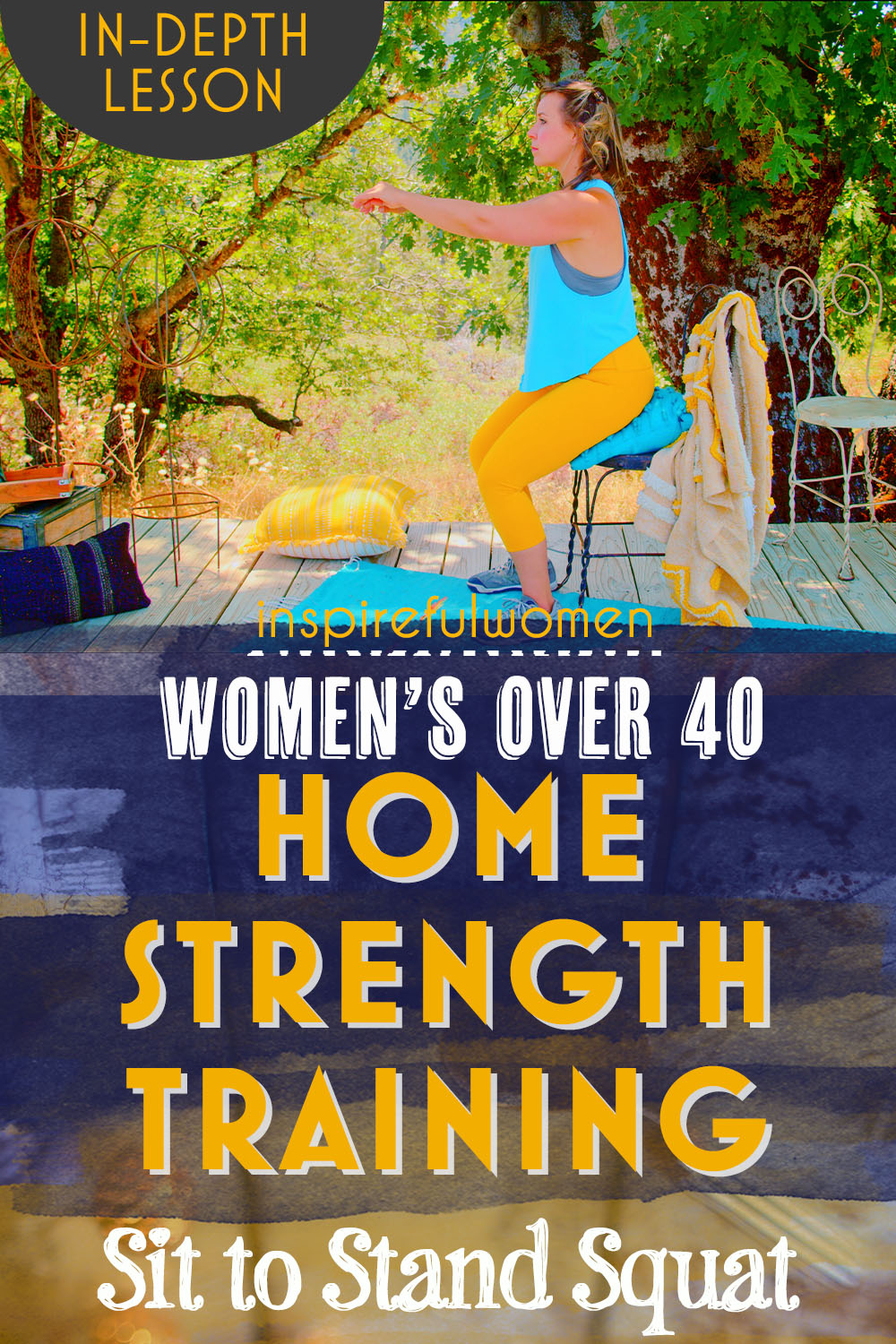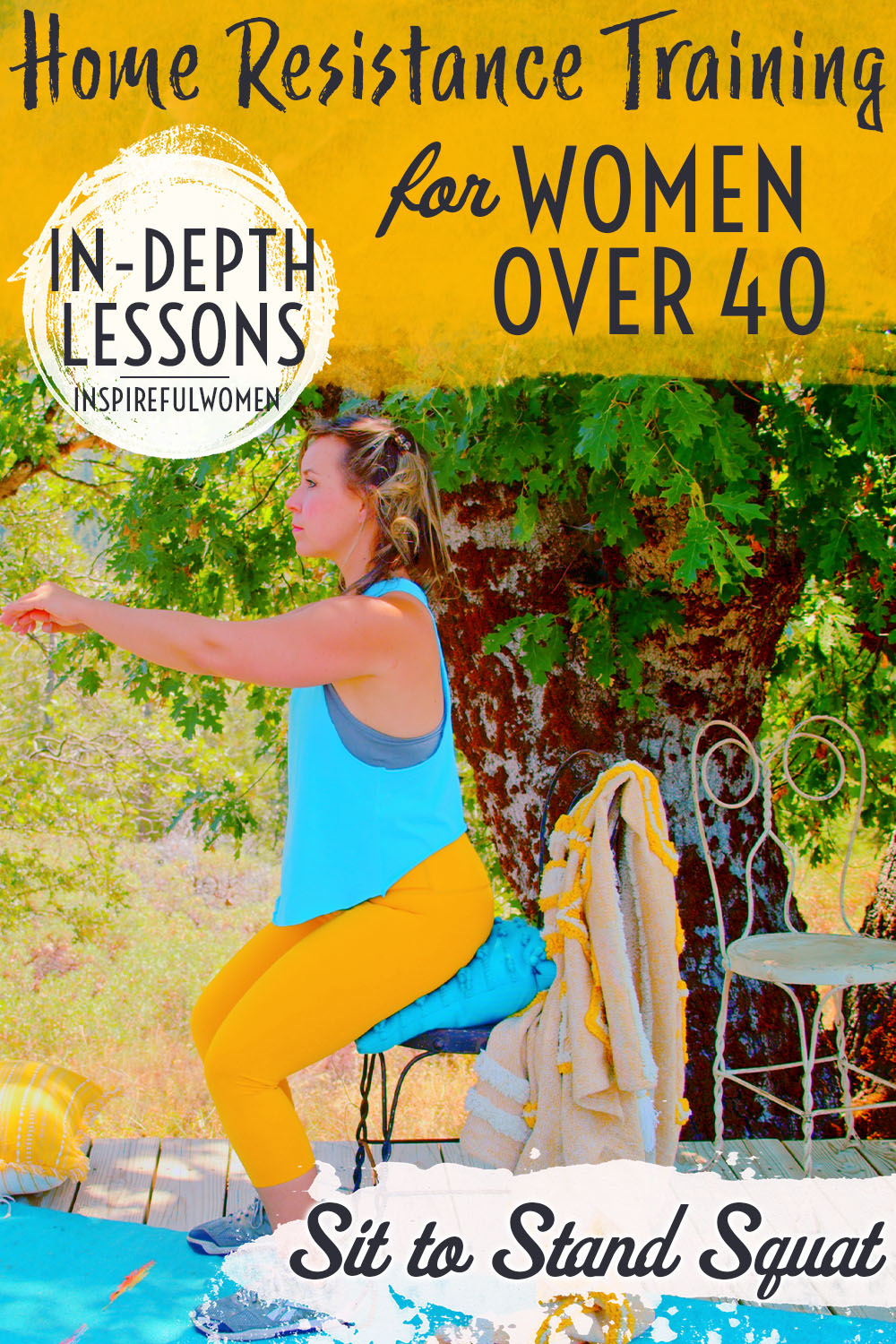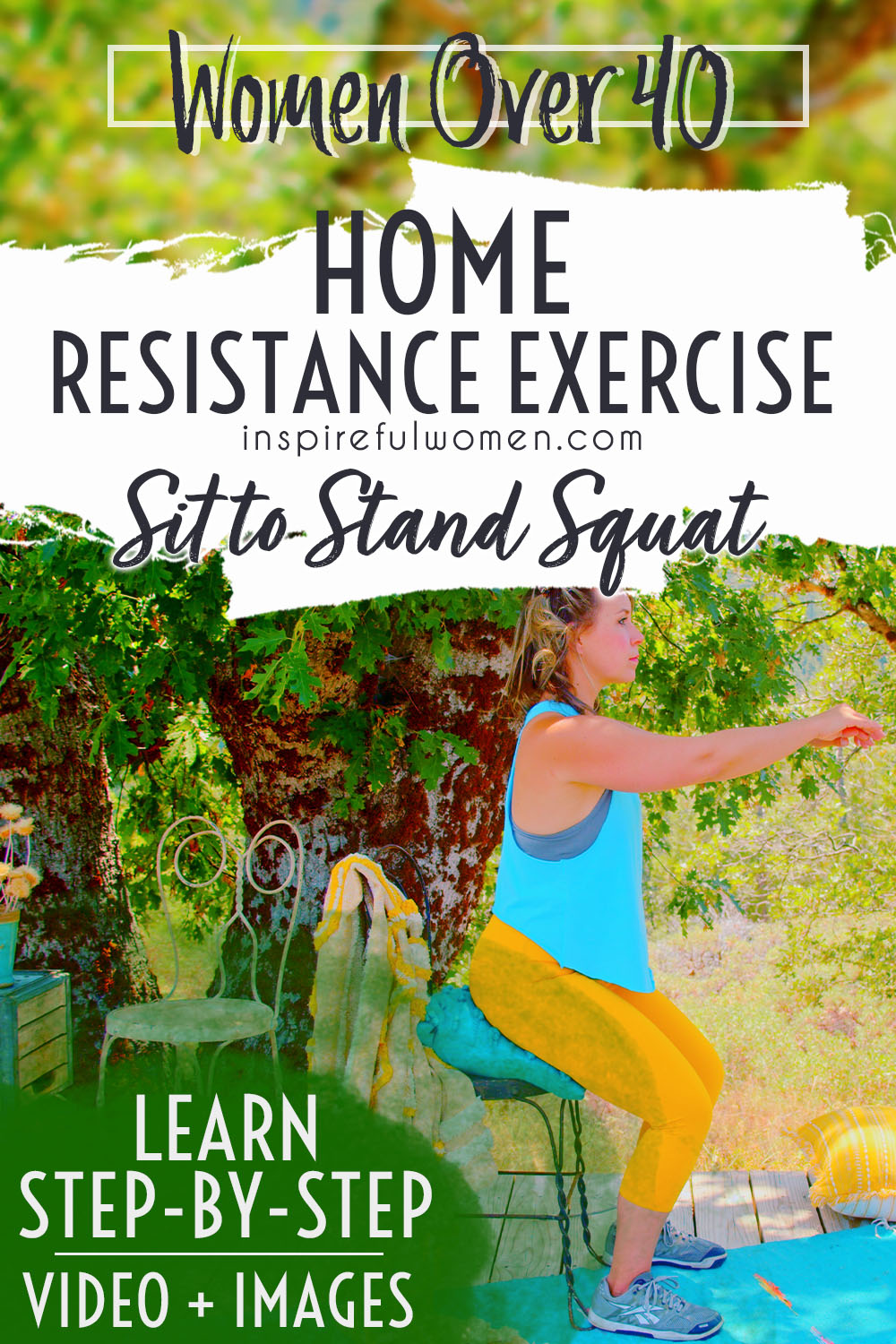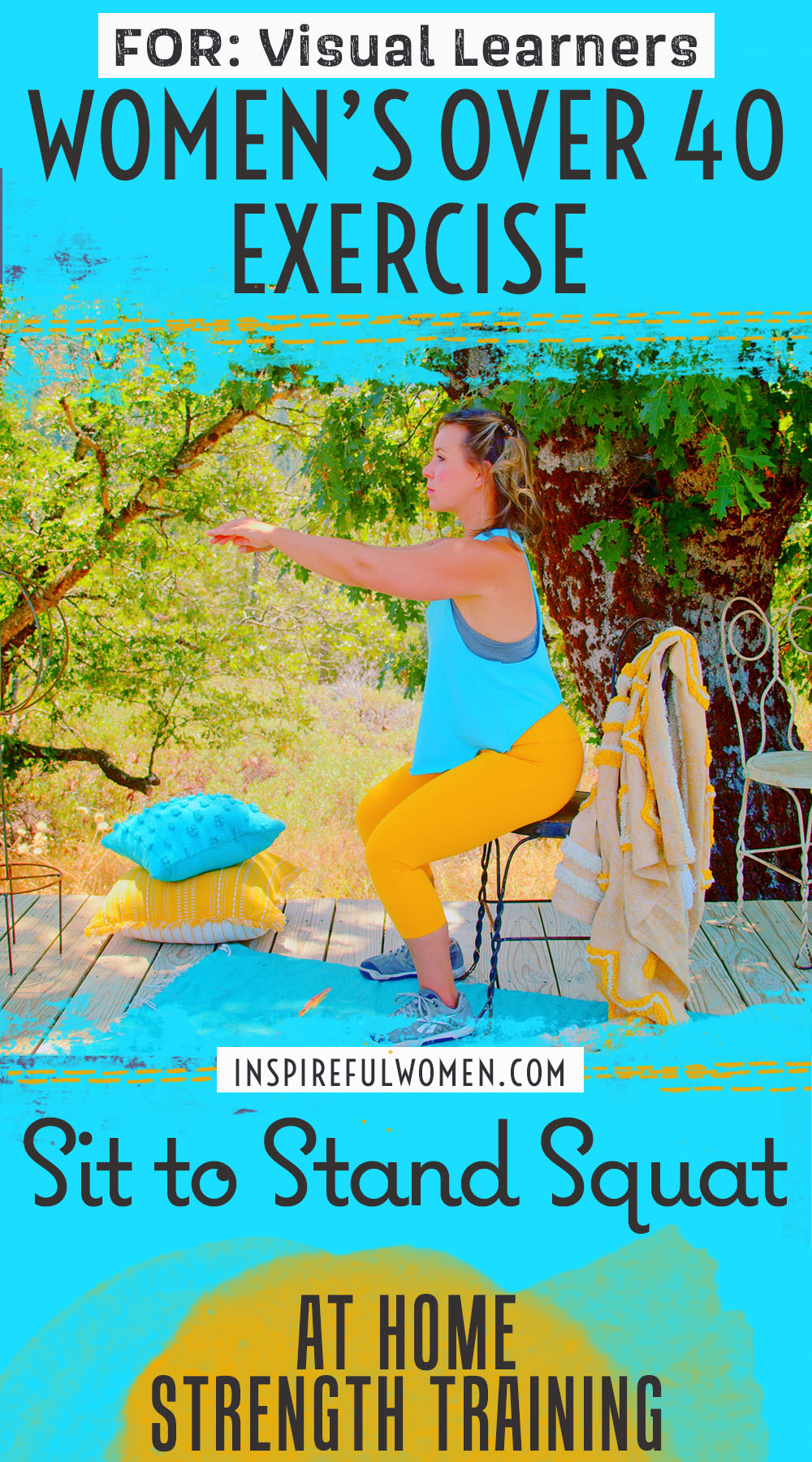Sit to Stand Squat
How to Do the Sit-to-Stand Squat - Modification for Bad Knees | In-Depth Guide [VISUAL LEARNERS] Beginner
Proper Form, Common Mistakes & Variations | Home Resistance Training
WHAT DO YOU WANT TO SEE?
QUICK DEMO
QUICK DEMO
MUSCLES THIS WORKS
MUSCLES
MAIN MUSCLES WORKED IN the Sit to Stand Squat
QUADRICEPS & GLUTEUS MAXIMUS
OTHER MUSCLES WORKED:
- Gastroc/Soleus
- Hamstrings
- Erector Spinae
STARTING POINTERS
Starting Pointers
WHAT WE'RE DOING TODAY
The Sit-to-Stand Squat is an effective exercise that helps improve lower body strength and mobility.
Main reason for choosing: The Sit to Stand Squat is appropriate for people with knee pain, limited range of motion in their ankles or hips, or those who are having difficulty doing a standard squat without rolling up onto their toes.
Sit to Stand Squats are very functional, we use the same movement all day long to get up from a chair or toilet. The movement is done using a box, chair, or bench, some stable surface, that you are able to lower yourself down to. The height of the surface is very important, and probably one of the most challenging things about this exercise. Choose a height that allows you to complete the movement with good form - neutral spine, not rolling to toes, with no pain, and challenging for the muscles. As you get stronger and more capable, you will be able to go down further, making it necessary to find a different “box” or choose a different version of the squat.
The Sit to Stand Squat is appropriate for people with knee pain, limited range of motion in their ankles or hips, or those who are having difficulty doing a standard squat without rolling up onto their toes. The squat includes a pause when the weight is touching down to the box, this allows you to relax the muscles briefly and recontract them to initiate the next rep. This is a good way to improve body awareness and control over muscle activation. Depending on your physical condition, history of injury, joint limitations, etc., and goals for the exercise, you may want to progress to a lower surface, add weight, or progress to other versions of the squat.
HOW TO DO THE EXERCISE
LOOKS
HOW Sit to Stand SquatS SHAPE OUR BODY
Firm and shapely thighs and buttocks.
PROPER FORM
PROPER FORM: Sit to Stand Squats
EQUIPMENT, SETS & REPS
EQUIPMENT
Wooden box, chair, coffee table, stool, bench - of a height that is doable but challenging.
SUGGESTED STARTING WEIGHT FOR WOMEN:
Bodyweight
SETS & REPS:
2 sets of 8 reps
PACE:
Slow and controlled up and down.
BODY POSITION
BODY POSITION FOR THE Sit to Stand Squat
Sit on the edge of the “box”
FEET: Flat on the floor, bend your knees to pull your heels back close to the bottom of the “box”.
BODY STANCE: Sitting up tall on the edge of the “box”. Neutral spine, sternum lifted, shoulder blades down and in. Hinge forward so that your shoulders are over your midfoot.
ARMS: Arms out to the front to counterbalance your weight as you squat.
HOW TO DO
HOW TO DO Sit to Stand SquatS
CUE: Push your hips back as you lower back down to the box.
Push down into your feet and straighten your ankle, knee, and hip to lift your bottom up off of the box.
Continue to push all the way up until your ankles, knees, and hips are straight.
Push your hips back, bending at your hips, knees, and ankles to lower yourself back down and stop briefly on the box.
Push back up to begin the next rep.
HOW TO SAFELY GET OUT OF THE EXERCISE
Push up to stand.
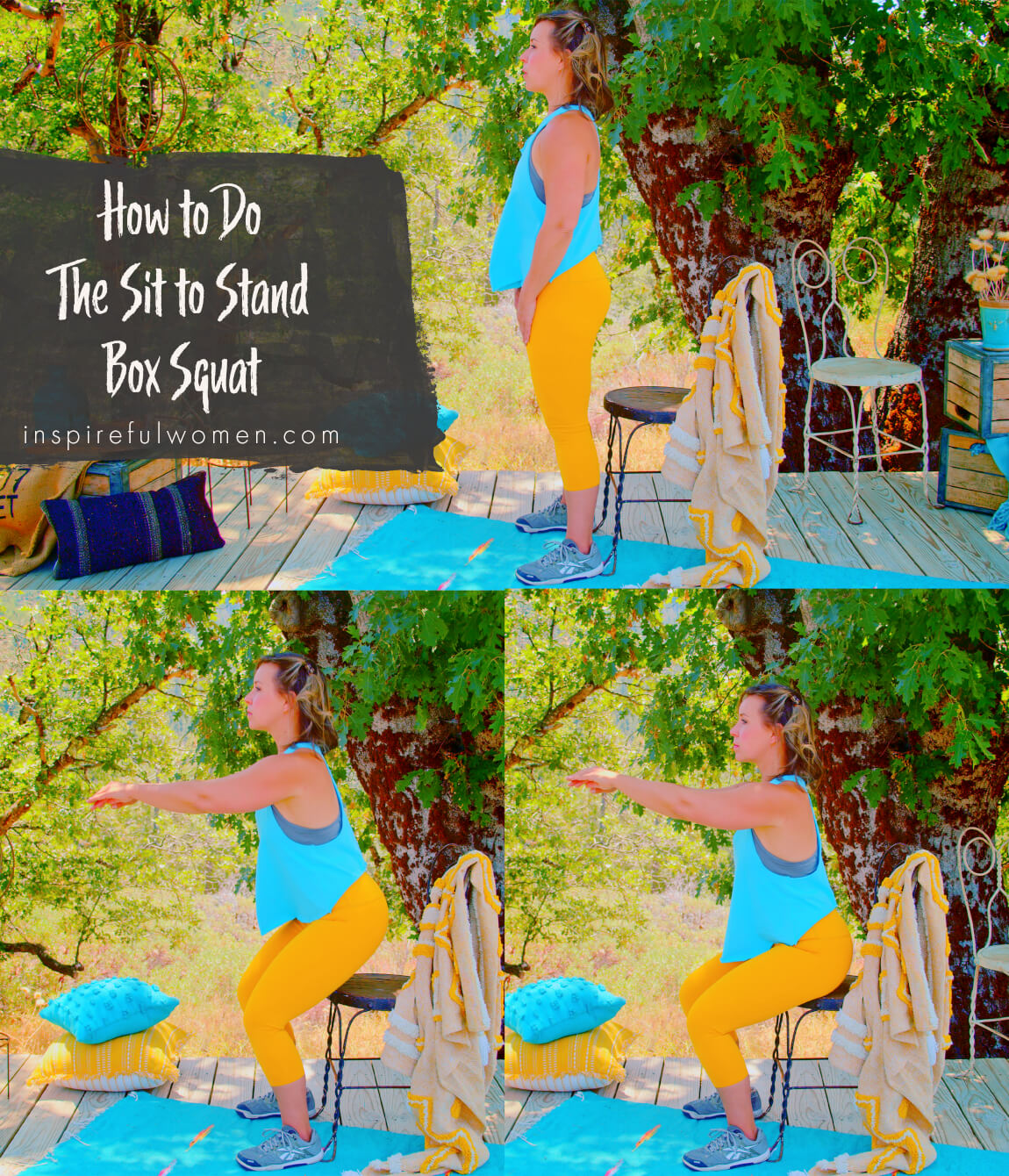
COMMON MISTAKES
COMMON MISTAKES
WHAT TO AVOID WITH THE Sit to Stand Squat
KEY TIP:
Guess what? Good news! Many avoids are the same for most movements. Once you learn the basics, there's really only a few extra avoids for each individual movement.
1. Avoid Plopping Down without control
AVOID: “Plopping” when you are lowering down to sitting.
WHY NOT?
- The muscles are worked both going up and going down.
WHAT TO DO:
- Return to sitting with control and set your body down gently.
- This will really challenge the eccentric control of the muscles.
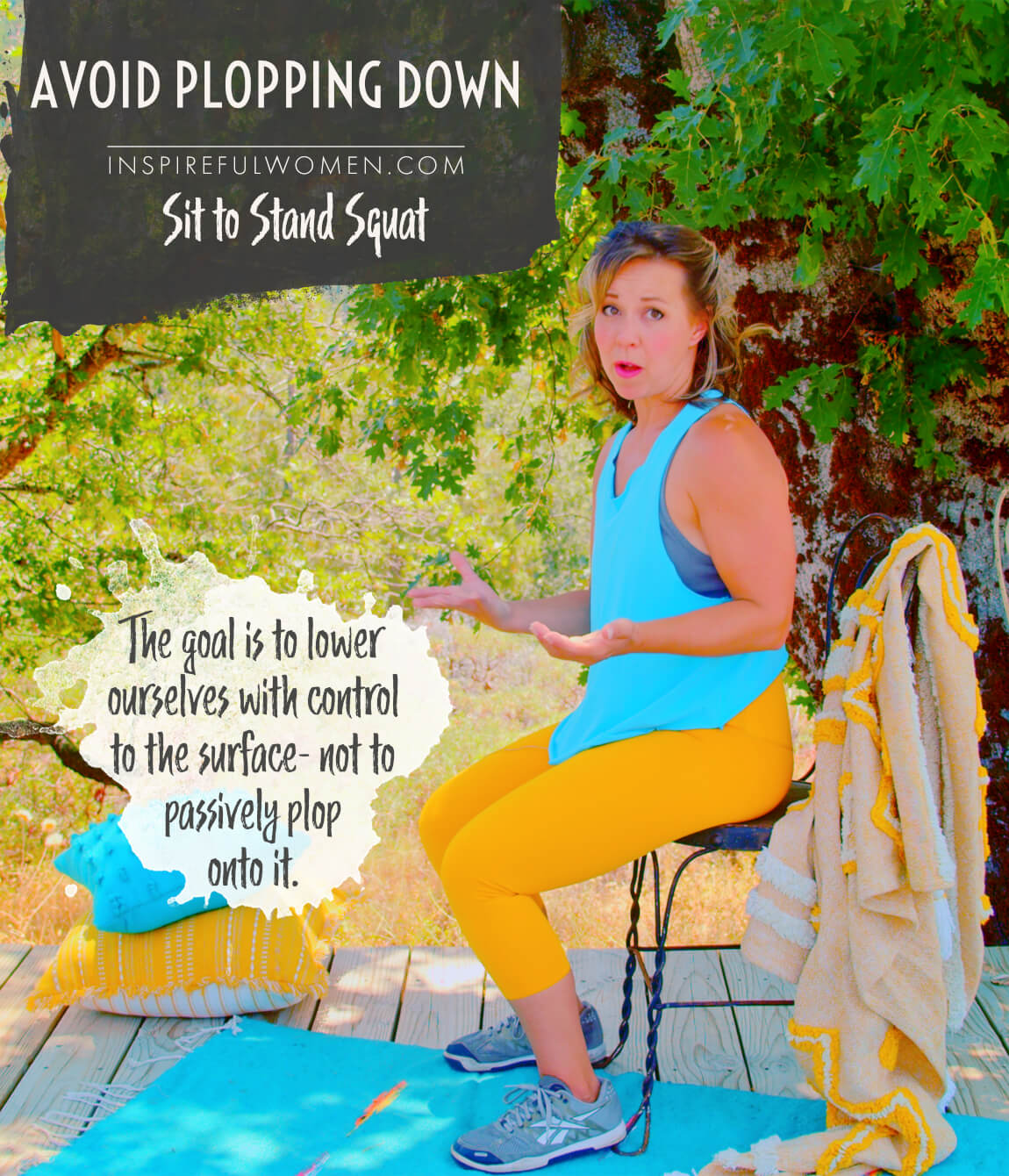
2. Avoid Rounding Spine/Tucking Tail
AVOID: Rounding your back/”tucking your tail”.
WHY NOT?
- This is the most common mistake made, in an attempt to go deeper into the squat the tailbone is tucked under.
- This can lead to increased pressure on the spine and lead to injury or damage over time.
- Tucking the tail, and rounding the low back defeats the purpose of going deeper into the squat.
- The goal for going deeper is to strengthen the core and increase the range of motion of the hips and ankles.
- Tucking the pelvis under does not increase the hip or ankle range of motion.
WHAT TO DO:
- Keep your spine from head to tailbone neutral throughout the movement.
- Keep your shoulders back and sternum lifted.
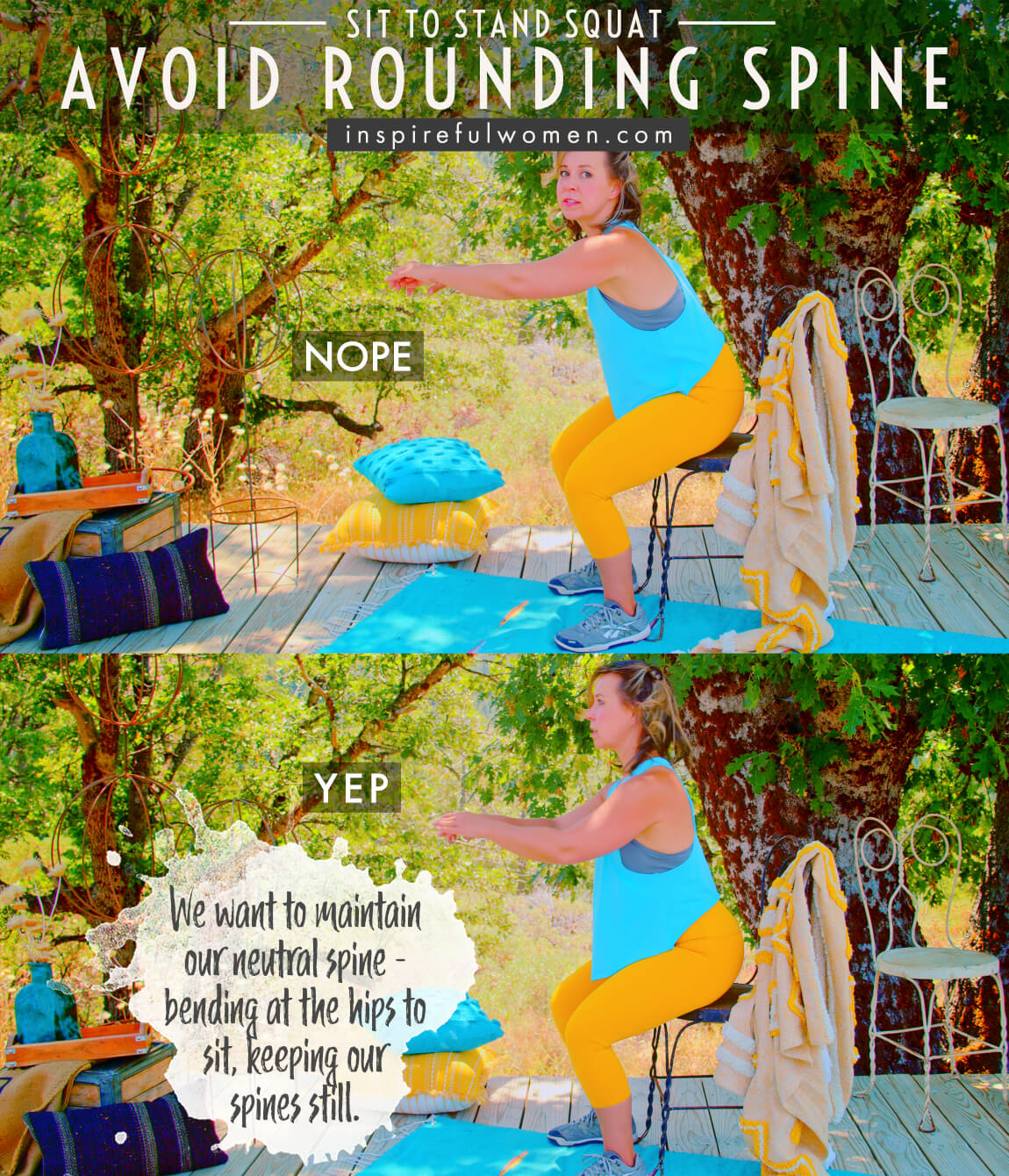
3. Avoid Shifting Weight Forward to Toes
AVOID: Leaning forward and using your back to help lift you.
WHY NOT?
- This happens when you let the shoulders come too far forward or when you round the back.
- The tendency is to lean forward to take the weight off of your hips when your upper body pulls the hips up off of the seat and then you move your shoulders back to straighten back up. This uses gravity to do the work - not the leg muscles.
- This can put too much pressure on the front of your knee and lumbar spine joints.
WHAT TO DO:
- Try to keep the weight equally on the bottom of the feet - think about pressing the whole bottom of the foot down.
- Push up with your leg muscles.
- Keep the torso as vertical as possible.
- This requires core strength.
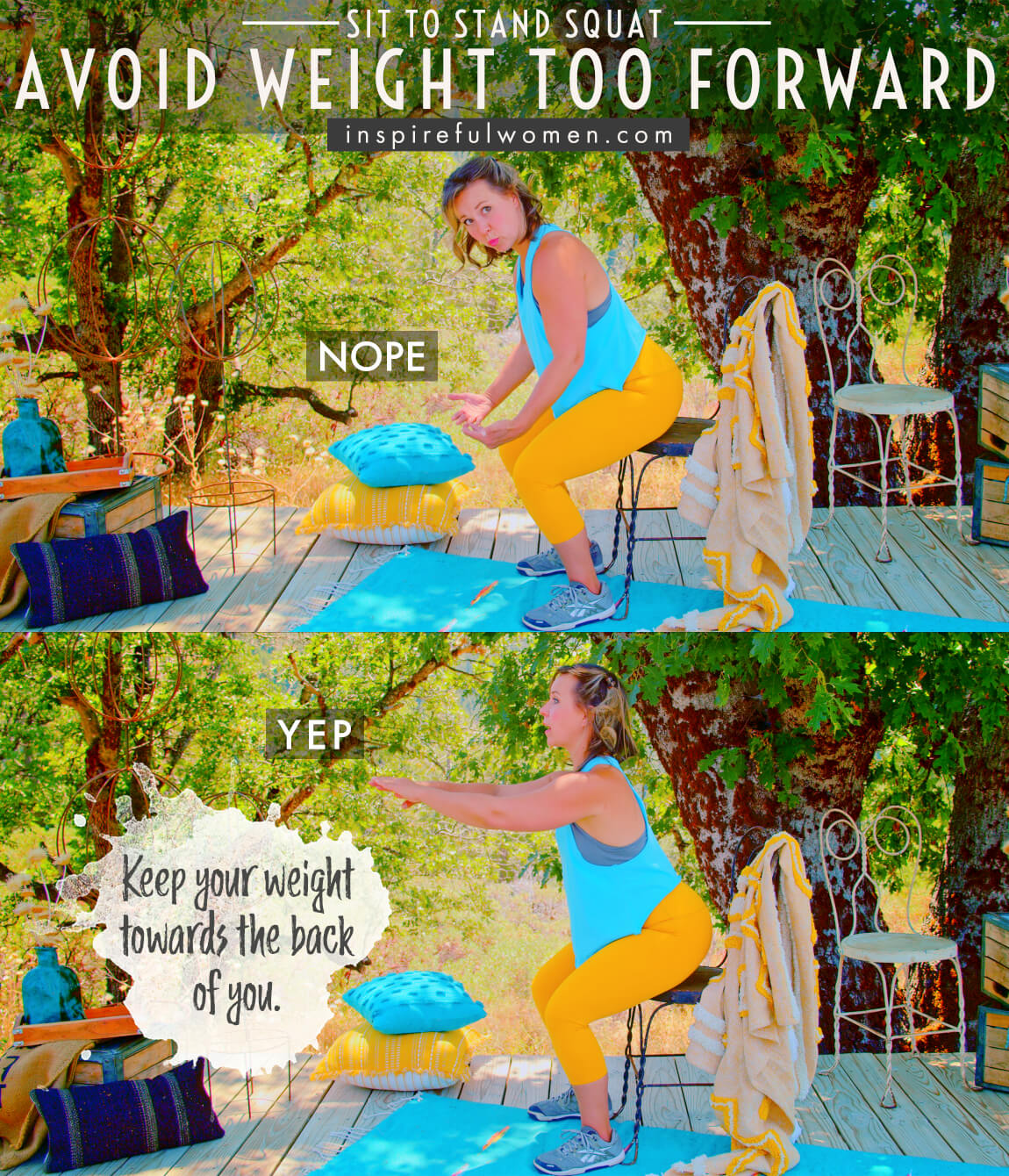
VARIATIONS
VARIATIONS
VARIATIONS OF Sit to Stand Squats
Use Pillow If need higher surface
Add Pillow For Height
Use a pillow or folded blanket to raise the surface if needed.
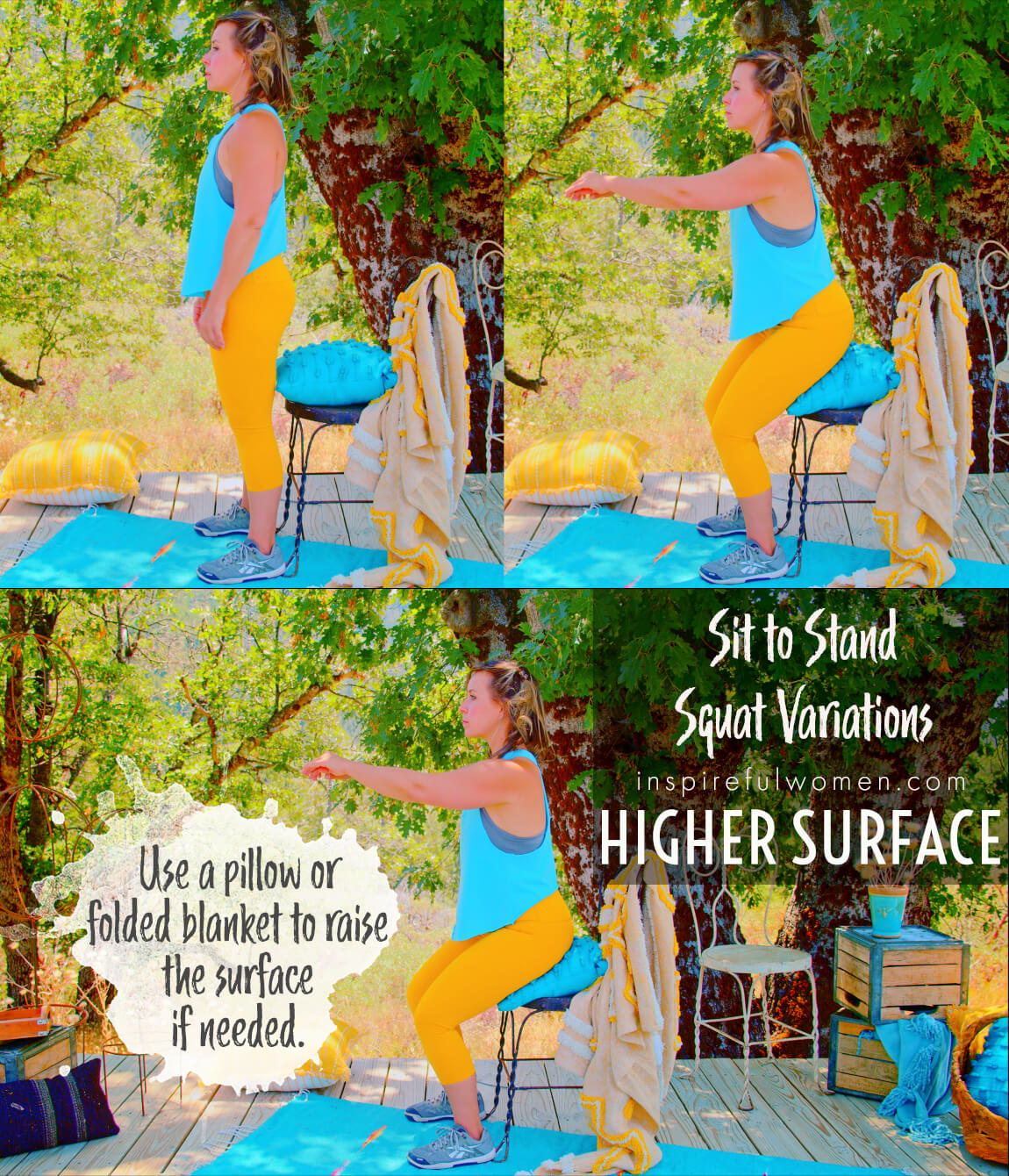
CONSTANT TENSION
Not Fully Sitting Keep Tension On Muscle
Stop just short of sitting down completely - just barely making contact with the box/chair. This will keep the muscles engaged, increasing the time the muscle is under tension. It is important to come to a full stop to avoid using momentum, so pause and hold briefly before pushing back up.
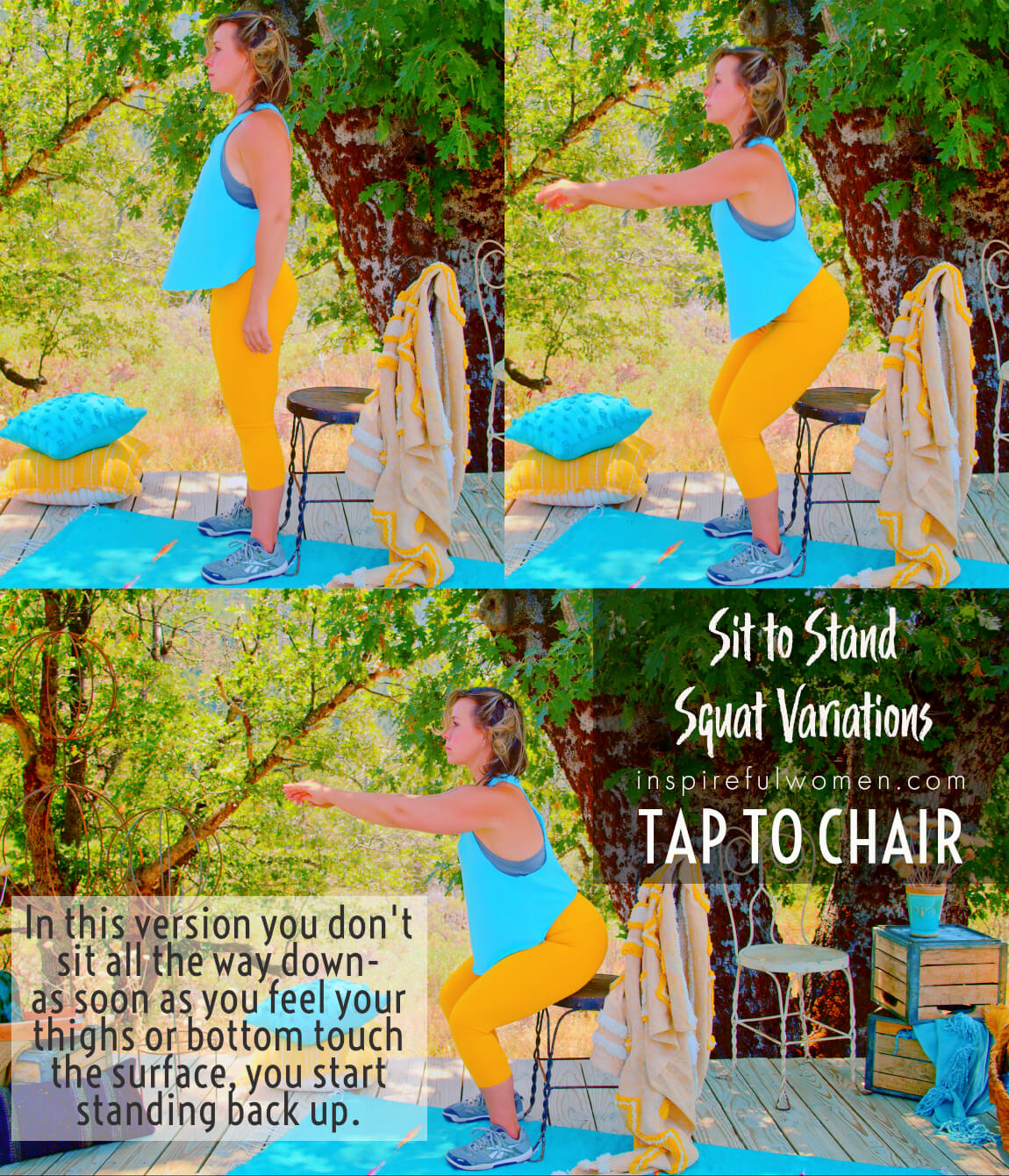
WHAT WE'RE DOING TODAY
WHAT & WHY
BENEFITS OF TRAINING THE Quadriceps
WHAT
This is a bodyweight isometric quadricep exercise. Squats can be modified to change the focus of the movement and can help us to improve in an area of our squat that we might be having trouble with.
The modifications all require the use of some sort of equipment, either a ball, wall, box (bench or chair), dumbbell, or band. Choosing which modified squats to do should be based on your ability and your goals. Squats can be slightly modified to accommodate personal limitations in core strength, hip, knee, ankle, or upper back stiffness or muscle tightness, and leg strength. The modifications do not necessarily make the exercise easier, just different. All of the modified versions of the squat focus on strengthening the quadriceps and gluteus maximus muscles, and involve movement at the ankle, knee, and hips.
- If you want to improve the muscular endurance and strength of the quadricep muscles:
- Try Wall Squats
- If you have difficulty:
- Keeping the heels on the floor during the basic squat
- Try: Wall Squat, Ball Squat, or Box Squat.
- Keeping the upper body upright (parallel with the shins/leaning the head and shoulders too far forward)
- Try: Wall Squat, Ball Squat, or Banded squat.
- Keeping your spine in neutral or back pain by squatting
- Try: Ball Squat
- Keeping the heels on the floor during the basic squat
- If you want to work on getting the thighs past parallel to the floor
- Try: Ball Squat or Banded Squat
Keeping the small curve in the low back as you squat down can be hard for a lot of people. It may be helpful to actively pull yourself down at the beginning of the squat. One of the hip flexors (iliopsoas) is attached to the low back (the lumbar part of the spine). Activating these muscles can make it easier to hold the low back in a neutral position.
WHY BOTHER DOING IT?
WHY
WHY DO WE EVEN CARE?
Squats are very functional and fairly simple to do. Our bodies were designed to squat - our ancestors squatted for many of their daily activities - like eating, washing clothes, going to the bathroom, and even talking. If you have the opportunity to watch children play, it is amazing to move in and out of a perfect squat position without effort, and hold the position while they play. However, if you’ve seen this, you’ve also properly thought, “wow I could never get into the position that kids hang out in.” Or we might be thinking just how much discomfort we’d be in if we tried to do that.
ACQUIRE/IMPROVE GOOD FORM WITH MODIFIED SQUATS
If you are not in the habit of squatting it can be challenging to do a squat. Personal limitations can interfere with your ability to squat in the correct form. It may be very useful to start with a modified version to build up the strength and joint mobility to be able to squat.
All of the modified squats do a great job of strengthening the leg muscles. In fact, the wall sit is the best squat to use to recruit more motor units - in other words - to activate the individual muscle fibers - get more muscles involved in the exercise. When you hold your body weight in the wall sit position the muscle fibers fatigue. In order to stay in the position, more fibers are recruited to help out. This is a nice way to improve your mind-body connection and the ability to activate more of the muscle. The wall sit works really well for this because you are holding the position where the muscle is being challenged the most (thighs parallel to the floor).
PUT MOVEMENT BACK WHERE IT BELONGS, AND GET RID OF MOVEMENT WHERE IT DOESN’T BELONG.
With age we tend to lose mobility in the ankles and hips - they get stiffer. When those joints get stiffer, it changes the way that we move. We begin to use our low backs more and our legs less. Over time this leads to backs that move too much and weaker legs. Slowly there can be a trend towards taking smaller steps when walking, not wanting to get down on the floor, using the hands to get up from the floor, and using gravity and the arms to help get out of chairs and upstairs. Adding squats to your workout can help prevent this from happening.
EVERYDAY LIFE
EVERYDAY LIFE &
MUSCLE FUNCTION
HOW WE USE OUR QUADS AND GLUTES IN EVERYDAY LIFE
The quadriceps and gluteus maximus muscles work together in activities that involve straightening the knee and the hip at the same time.
1. JUMPING
2. CLIMBING
3. GOING UP AND DOWN STAIRS
4. TRANSITIONING SIT TO STANDING TO SIT
- Sitting in chairs
- In and out of cars
- On and off of the toilet
5. SQUATTING DOWN/GETTING UP
- Getting things out of the bottom shelf
- Getting up and down from the floor
- Gardening
- Picking items or kids up
6. SHOCK ABSORBERS TO PROTECT THE ANKLE, KNEE, AND HIP JOINTS DURING:
- Walking
- Running
- Jumping
7. STABILIZES THE KNEE JOINT DURING ALL ACTIVITY THAT INVOLVES BENDING AND STRAIGHTENING THE KNEE.
- Positions the kneecap in the groove of the femur during knee movement
HOW TO FEEL WHAT MUSCLE IS WORKING
How to Feel What Muscle is Working
Quadriceps: Sitting upright, place your hand on the front of your thigh (of the test leg). Hook the ankle of the other leg to hold the test leg (the leg that your hand is resting on) in place. Try to straighten the test leg by lifting the foot. You will feel your quadriceps contract.
Gluteus Maximus: Place your hands on your bottom - about where they would be if you put your hands in your back pockets - with the palms on your buttocks. Push down into both feet as if you were pressing yourself up to standing. Try to keep the front of your thighs relaxed so that the muscles under your hands contract. Try activating only one side at a time.
SCIENCY STUFF
ALLLL MUSCLES & WHEN
ALL MUSCLES WORKING & WHEN DURING THE Sit to Stand Squat
Muscles of the torso will work throughout the exercise for keeping the torso upright and the spine in neutral.
The gluteus maximus and quadriceps femoris (vastus lateralis, vastus intermedius, and vastus medialis oblique) contract concentrically to straighten the hip and the knee joint as the body is pushed up. The gastrocnemius and soleus (two calf muscles) contract concentrically to pull the lower leg bone (tibia) back as the ankle straightens.
The quadriceps, gluteus maximus, gastrocnemius, and soleus work eccentrically to control the movement as the knee and hip bend to lower the body back down.
PIN IT FOR LATER!
